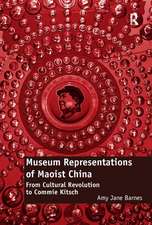White: Twentieth Anniversary Edition
Autor Richard Dyeren Limba Engleză Paperback – 2 feb 2017
White explores how, while racial representation is central to the organisation of the contemporary world, white people have remained a largely unexamined category in sharp contrast to the many studies of images of black and Asian peoples. Looking beyond the apparent unremarkability of whiteness, Dyer demonstrates the importance of analysing images of white people.
Dyer places this representation within the contexts of Christianity, ‘race’ and colonialism. In a series of absorbing case studies, he shows the construction of whiteness in the technology of photography and film as part of a wider ‘culture of light’; discusses heroic white masculinity in muscle-man action cinema, from Tarzan and Hercules to Conan and Rambo; analyses the stifling role of white women in end-of-empire fictions like Jewel in the Crown and traces the associations of whiteness with death in Falling Down, horror movies and cult dystopian films such as Blade Runner and the Aliens trilogy.
This twentieth anniversary edition includes a new introductory chapter by Maxime Cervulle entitled ‘Looking into the light: Whiteness, racism and regimes of representation’. This new introduction illuminates how Dyer has made a major contribution to the study of contemporary regimes of representation by unveiling the cultural mechanisms that have formed and reinforced white hegemony, mechanisms under which white people have come to represent what is ordinary, neutral, even universal.
| Toate formatele și edițiile | Preț | Express |
|---|---|---|
| Paperback (1) | 280.70 lei 3-5 săpt. | +20.60 lei 7-11 zile |
| Taylor & Francis – 2 feb 2017 | 280.70 lei 3-5 săpt. | +20.60 lei 7-11 zile |
| Hardback (1) | 741.27 lei 6-8 săpt. | |
| Taylor & Francis – feb 2017 | 741.27 lei 6-8 săpt. |
Preț: 280.70 lei
Nou
Puncte Express: 421
Preț estimativ în valută:
53.72€ • 58.33$ • 45.12£
53.72€ • 58.33$ • 45.12£
Carte disponibilă
Livrare economică 01-15 aprilie
Livrare express 18-22 martie pentru 30.59 lei
Preluare comenzi: 021 569.72.76
Specificații
ISBN-13: 9781138683044
ISBN-10: 1138683043
Pagini: 304
Dimensiuni: 156 x 234 x 22 mm
Greutate: 0.4 kg
Ediția:2 ed
Editura: Taylor & Francis
Colecția Routledge
Locul publicării:Oxford, United Kingdom
ISBN-10: 1138683043
Pagini: 304
Dimensiuni: 156 x 234 x 22 mm
Greutate: 0.4 kg
Ediția:2 ed
Editura: Taylor & Francis
Colecția Routledge
Locul publicării:Oxford, United Kingdom
Public țintă
Postgraduate and UndergraduateCuprins
Contents
List of plates
Acknowledgements
Looking into the light: Whiteness, racism and regimes of representation
Maxime Cervulle
Introduction
1 The matter of whiteness
2 Coloured white, not coloured
3 The light of the world
4 The white man’s muscles
5 ‘There’s nothing I can do! Nothing!’
6 White death
Notes
Bibliographies
Index
List of plates
Acknowledgements
Looking into the light: Whiteness, racism and regimes of representation
Maxime Cervulle
Introduction
1 The matter of whiteness
2 Coloured white, not coloured
3 The light of the world
4 The white man’s muscles
5 ‘There’s nothing I can do! Nothing!’
6 White death
Notes
Bibliographies
Index
Descriere
Now 20 years since its initial release, Richard Dyer’s classic text White remains a groundbreaking and insightful study of the representation of whiteness in Western visual culture.
White explores how, while racial representation is central to the organisation of the contemporary world, white people have remained a largely unexamined category in sharp contrast to the many studies of images of black and Asian peoples. Looking beyond the apparent unremarkability of whiteness, Dyer demonstrates the importance of analysing images of white people.
Dyer places this representation within the contexts of Christianity, ‘race’ and colonialism. In a series of absorbing case studies, he shows the construction of whiteness in the technology of photography and film as part of a wider ‘culture of light’; discusses heroic white masculinity in muscle-man action cinema, from Tarzan and Hercules to Conan and Rambo; analyses the stifling role of white women in end-of-empire fictions like Jewel in the Crown and traces the associations of whiteness with death in Falling Down, horror movies and cult dystopian films such as Blade Runner and the Aliens trilogy.
This twentieth anniversary edition includes a new introductory chapter by Maxime Cervulle entitled ‘Looking into the light: whiteness, racism and regimes of representation’. This new introduction illuminates how Dyer has made a major contribution to the study of contemporary regimes of representation by unveiling the cultural mechanisms that have formed and reinforced white hegemony, mechanisms under which white people have come to represent what is ordinary, neutral, even universal.
White explores how, while racial representation is central to the organisation of the contemporary world, white people have remained a largely unexamined category in sharp contrast to the many studies of images of black and Asian peoples. Looking beyond the apparent unremarkability of whiteness, Dyer demonstrates the importance of analysing images of white people.
Dyer places this representation within the contexts of Christianity, ‘race’ and colonialism. In a series of absorbing case studies, he shows the construction of whiteness in the technology of photography and film as part of a wider ‘culture of light’; discusses heroic white masculinity in muscle-man action cinema, from Tarzan and Hercules to Conan and Rambo; analyses the stifling role of white women in end-of-empire fictions like Jewel in the Crown and traces the associations of whiteness with death in Falling Down, horror movies and cult dystopian films such as Blade Runner and the Aliens trilogy.
This twentieth anniversary edition includes a new introductory chapter by Maxime Cervulle entitled ‘Looking into the light: whiteness, racism and regimes of representation’. This new introduction illuminates how Dyer has made a major contribution to the study of contemporary regimes of representation by unveiling the cultural mechanisms that have formed and reinforced white hegemony, mechanisms under which white people have come to represent what is ordinary, neutral, even universal.

















